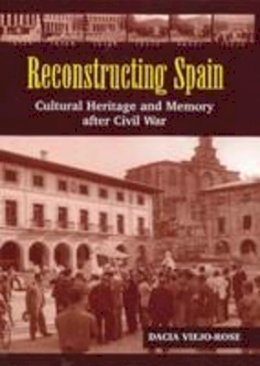
Stock image for illustration purposes only - book cover, edition or condition may vary.
Reconstructing Spain
Dacia Viejo-Rose
€ 155.20
FREE Delivery in Ireland
Description for Reconstructing Spain
Hardcover. Explores the role of cultural heritage in post-conflict reconstruction, whether as a motor for the prolongation of violence or as a resource for building reconciliation. This book focuses on the material practices and rhetorical strategies developed around cultural heritage in post-civil war Spain and the victorious Franco regime's reconstruction. Num Pages: 272 pages, illus. BIC Classification: 1DSE; 3JJG; GM; HBJD; HBLW; HBWP; JFC. Category: (G) General (US: Trade). Dimension: 252 x 171 x 25. Weight in Grams: 786.
This book explores the role of cultural heritage in post-conflict reconstruction, whether as a motor for the prolongation of violence or as a resource for building reconciliation. The research was driven by two main goals: to understand the post-conflict reconstruction process and to identify how this process evolves in the medium term and the impact it has on society. The Spanish Civil War (1936-39) and its subsequent phases of reconstruction provides the primary material for this exploration. In pursuit of the first goal, the book centers on the material practices and rhetorical strategies developed around cultural heritage in post-civil war Spain and the victorious Franco regime's reconstruction. The analysis captures a discursively complex set of practices that made up the reconstruction and in which a variety of Spanish heritage sites were claimed, rebuilt or restored, and represented - as signs of historical narratives, political legitimacy, and group identity. The reconstruction of the town of Gernika is a particularly emblematic instance of destruction and a significant symbol within the Basque regions of Spain, as well as internationally. By examining Gernika, it is possible to identify some of the trends common to the reconstruction as a whole, along with those aspects that pertain to its singular symbolic resonance. In order to achieve the second goal, the book examines the processes of selection, value change, and exclusionary dynamics of reconstruction. Exploring the possible impact of post-civil war reconstruction in the medium term is conducted in two time frames: the period of political transition that followed General Franco's death in 1975, and the 2004-2008 period when Rodriguez Zapatero's government undertook initiatives to 'recover the historic memory' of the war and dictatorship. Finally, the observations made of the Spanish reconstruction are analyzed in terms of how they might reveal general trends in post-conflict reconstruction processes in relation to cultural heritage. These insights are pertinent to the situations in Cambodia, Bosnia and Herzegovina, Afghanistan, and Iraq.
Product Details
Format
Hardback
Publication date
2011
Publisher
Sussex Academic Press United Kingdom
Number of pages
272
Condition
New
Number of Pages
272
Place of Publication
Liverpool, United Kingdom
ISBN
9781845194352
SKU
V9781845194352
Shipping Time
Usually ships in 7 to 11 working days
Ref
99-1
About Dacia Viejo-Rose
Dacia Viejo-Rose is a College Research Associate at Jesus College, Cambridge, and a post-doctoral researcher on the European Commission funded research project "Cultural Heritage & the Reconstruction of Identities After Conflict" (CRIC) based at the McDonald Institute for Archaeological Research, University of Cambridge. In 2006 she founded the Cambridge Post-Conflict and Post-Crisis group and continues to co-organise it.
Reviews for Reconstructing Spain
